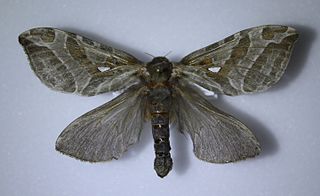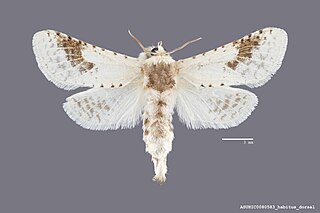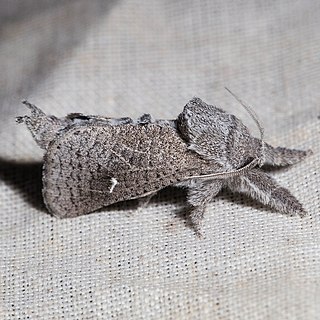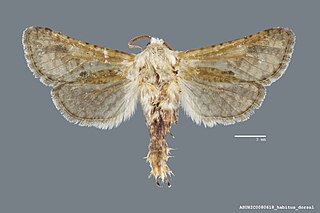
Sthenopis argenteomaculatus, the silver-spotted ghost moth, is a species of moth of the family Hepialidae. It was described by Thaddeus William Harris in 1841, and is known in North America from Nova Scotia to North Carolina and west to Minnesota.

Apantesis anna, the Anna tiger moth, is a moth of the family Erebidae. It was described by Augustus Radcliffe Grote in 1863. It is found from Maine to the mountains of North Carolina, west to Nebraska and Arkansas.

Givira mucida is a moth in the family Cossidae. It is found in North America, where it has been recorded from California east to south-eastern New Mexico.
The Hypoptinae are a subfamily of the family Cossidae.
Givira is a genus of moths in the family Cossidae.
Givira arbeloides is a moth in the family Cossidae. It is found in North America, where it has been recorded from Arizona, Arkansas, Louisiana, Mississippi and Texas..
Givira carla is a moth in the family Cossidae. It is found in North America, where it has been recorded from California and Arizona.
Givira cleopatra is a moth in the family Cossidae first described by William Barnes and James Halliday McDunnough in 1912. It is found in North America, where it has been recorded from Arizona, California, Nevada and Utah.

Givira theodori is a moth in the family Cossidae. It is found in the United States, where it has been recorded from Arizona, Colorado, Utah, New Mexico and Texas.

Givira lotta, the pine carpenterworm moth, is a moth in the family Cossidae. The species was first described by William Barnes and James Halliday McDunnough in 1910. It is found in the United States, where it has been recorded from California, Arizona, New Mexico and Colorado. The habitat consists of pine forests.

Givira marga is a moth in the family Cossidae first described by William Barnes and James Halliday McDunnough in 1910. It is found in North America, where it has been recorded from California and Arizona.

Givira minuta is a moth in the family Cossidae first described by William Barnes and James Halliday McDunnough in 1910. It is found in North America, where it has been recorded from southern Arizona.

Givira cornelia is a moth in the family Cossidae. It is found in North America, where it has been recorded from Utah, Arizona, California and Nevada.
Givira durangona is a moth in the family Cossidae described by William Schaus in 1901. It is found in Mexico (Durango) and the United States, where it has been recorded from Colorado.
Givira ethela is a moth in the family Cossidae. It is found in North America, where it has been recorded from Arizona, California and Nevada.

Givira francesca is a moth in the family Cossidae. It is found in North America, where it has been recorded from Alabama, Florida, Mississippi, North Carolina and South Carolina.

Givira lucretia is a moth in the family Cossidae first described by William Barnes and James Halliday McDunnough in 1913. It is found in North America, where it has been recorded from Arizona, Texas and Wyoming.










